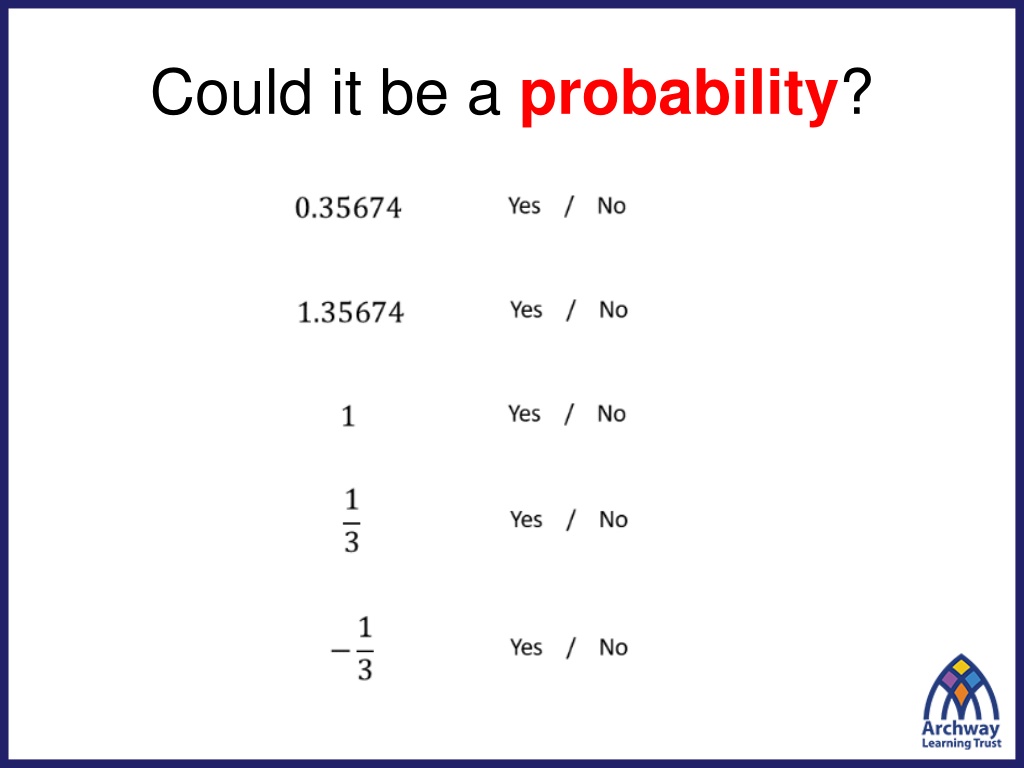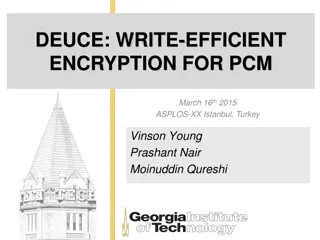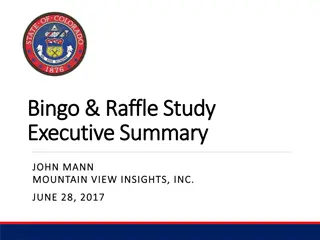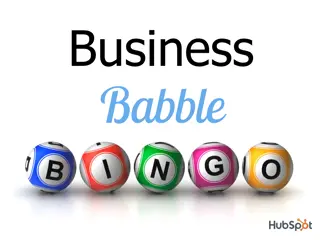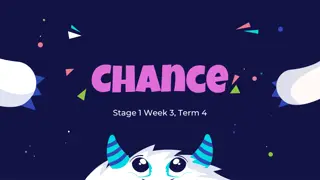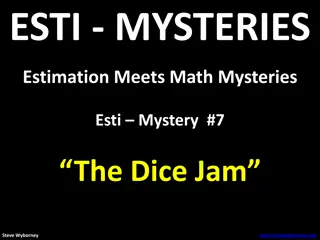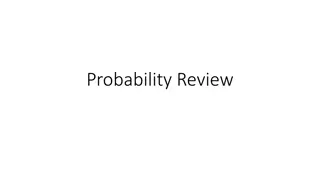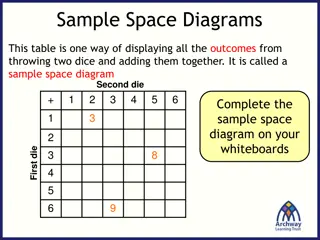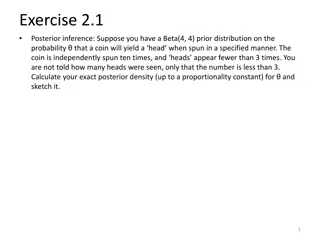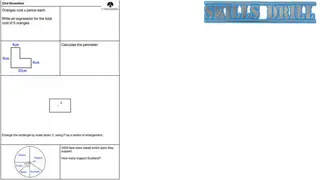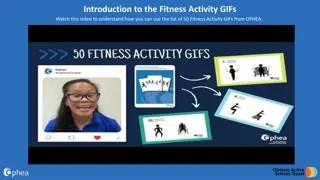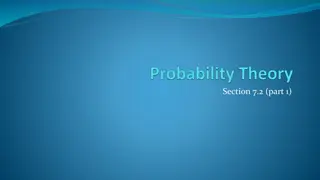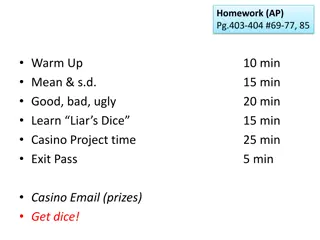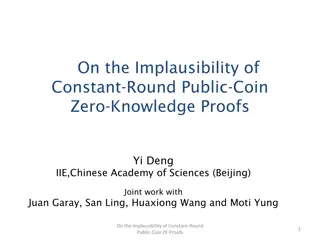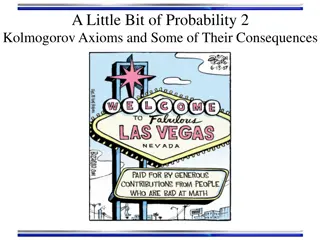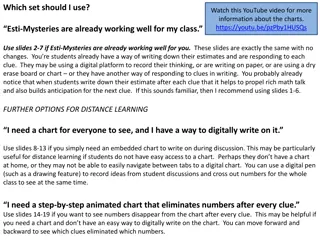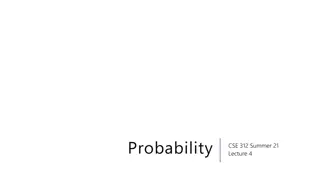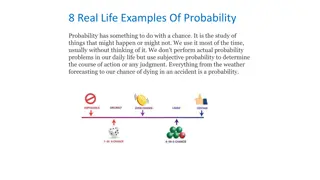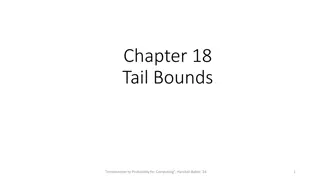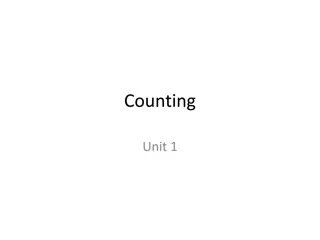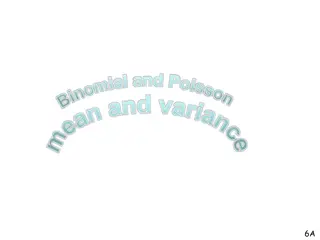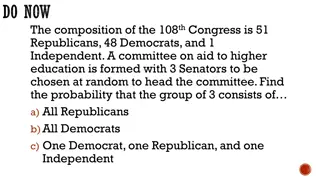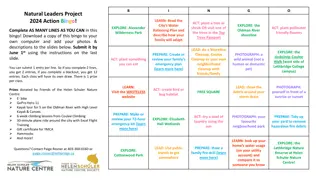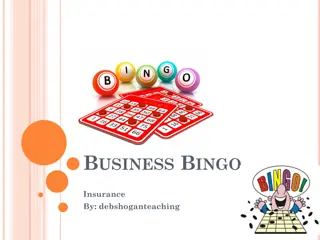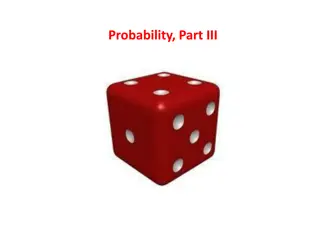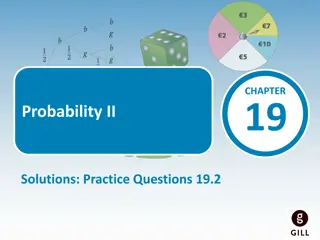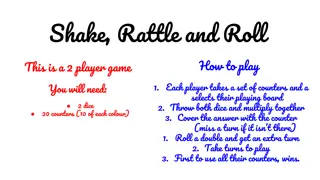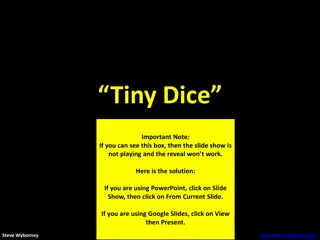Exploring Probability with Dice Bingo and Coin Flips
Delve into the world of probability through engaging activities such as Dice Bingo where players roll dice to achieve specific outcomes, analyzing relative frequencies, and understanding concepts like sample spaces and probabilities with dice and coin flips. Dive into the exciting realm of mathematical probability and enjoy learning through interactive games and discussions.
Download Presentation

Please find below an Image/Link to download the presentation.
The content on the website is provided AS IS for your information and personal use only. It may not be sold, licensed, or shared on other websites without obtaining consent from the author. Download presentation by click this link. If you encounter any issues during the download, it is possible that the publisher has removed the file from their server.
E N D
Presentation Transcript
Dice Bingo Two dice are going to be rolled. The two scores will added and the square containing that value can be crossed out. Only one square can be crossed out each time. Draw a 3 x 3 grid and fill it with numbers that could appear. The winner will cross out all of their numbers first.
Dice Bingo Score 2 3 4 5 6 7 8 9 10 11 12 Tally Frequency What proportion of rolls resulted in a score of 5? This proportion is known as the relative frequency.
Dice Bingo A two way table is way to list all possible outcomes. Explain why we should have expected the mode to be 7.
Dice Bingo The probability of scoring a 7 is 6 36 7 8 6 7 8 8 The relative frequency of scoring a 7 from our bingo game was: 6 4 5 5 6 7 8 6 7 7 8 Discuss: Why are these proportions different?
Dice Bingo: Round 2 This time the product of the two scores will be used and the square containing that value can be crossed out. Only one square can be crossed out each time. Draw a 3 x 3 grid and fill it with numbers that could appear. The winner will cross out all of their numbers first.
Dice Bingo: Round 2 Outcomes: Which values did you choose for your grid? Why?
1 2 3 4 5 6 1 1 2 3 4 5 6 2 2 4 6 8 10 12 3 3 6 9 12 15 18 4 4 8 12 16 20 24 5 5 10 15 20 25 30 6 6 12 18 24 30 36
A fair coin is flipped twice List all the possible outcomes H T H, H H, T T, H T, T H T What is the probability of flipping two heads?
A dice and a coin are thrown at the same time. a) Complete the Sample Space Diagram. Dice 2 3 1 4 6 5 H, 1 Head Coin T, 5 Tail b) Calculate the probability of scoring a 4 on the dice and a heads on the coin. c) Calculate the probability of scoring tails and an odd number on the dice. d) P(Heads and a number greater than 2) = e) P(NOT a 5 and NOT Heads) =
A 6-sided and a 4-sided die are thrown and the product of their results recorded. a) Complete a Sample Space Diagram. b) P(Even number) = e) P(NOT a prime number) = c) P(less than 10) = f) P(NOT a square number) = d) P(NOT more than 2) = g) P(11) =
TRUE or FALSE? A Copy out each card and complete the Sample Space Diagrams and mark them TRUE & FALSE B Two coins are flipped. Two coins are flipped. C A coin is flipped & a dice is thrown. 1 2 3 4 5 6 H T H T H, 1 H HH HT H H T, 1 T T T P (Tails & Tails) = 0.25 P (At least 1 Tails) = 0.5 P (Tails & Odd) = 1/4 D E F Two 4-sided spinners are spun & their scores added. Two 4-sided spinners are spun & their scores multiplied. A 6-sided dice and a 4-sided spinner: scores added. 1 2 3 2 3 4 1 1 2 2 3 3 4 4 1 2 3 2 3 4 3 4 5 6 1 2 3 4 1 2 3 4 1 2 3 4 P (6) = 4/16 P (More than 4) = 11/16 P (7 or less) = 0.75 G H I A 3-sided & a 8-sided spinner are spun & their scores added. 2 cube dice are rolled & their scores added. A 6-sided dice & a tetrahedron dice are rolled & their scores are multiplied. 1 2 2 3 3 4 5 6 7 8 1 2 3 P (Less than 6) = 5/12 P (More than 8) = 0.5 P (4 or 9) = 1/4 J K L Two 5-sided spinners: scores added. Two 5-sided spinners: scores multiplied. An octahedron & a cube dice are rolled & their scores are added. 1 2 3 2 3 4 3 4 5 1 2 3 4 5 5 10 15 20 25 1 2 3 4 5 1 2 3 4 5 P (9 or more) = 7/16 5 10 15 20 P (Less than 3 or exactly 20) = 0.2 P (3 or 6) = 0.15
TRUE or FALSE? A Cut out all 12 cards. Complete the Sample Space Diagrams and sort them into two piles: TRUE & FALSE B Two coins are flipped. Two coins are flipped. C A coin is flipped & a dice is thrown. 1 2 3 4 5 6 H T H T H, 1 H, 2 H, 3 H, 4 H, 5 H, 6 H HH HT HH HT H H T, 1 T, 2 T, 3 T, 4 T, 5 T, 6 T HT TT HT TT T T P (Tails & Tails) = 0.25 P (At least 1 Tails) = 0.5 P (Tails & Odd) = 1/4 D E F Two 4-sided spinners are spun & their scores added. Two 4-sided spinners are spun & their scores multiplied. A 6-sided dice and a 4-sided spinner: scores added. 1 2 3 4 5 2 3 4 5 6 3 4 5 6 7 4 5 6 7 8 1 1 2 3 4 2 2 4 6 8 3 3 6 9 12 4 4 8 12 16 1 2 3 4 5 2 3 4 5 6 3 4 5 6 7 4 5 6 7 8 5 6 7 8 9 6 7 8 9 10 1 2 3 4 1 2 3 4 1 2 3 4 P (6) = 4/16 P (More than 4) = 11/16 P (7 or less) = 0.75 G H I A 3-sided & a 8-sided spinner are spun & their scores added. 2 cube dice are rolled & their scores added. A 6-sided dice & a tetrahedron dice are rolled & their scores are multiplied. 1 2 3 4 2 3 4 5 3 4 5 6 4 5 6 7 5 6 7 8 6 7 8 9 7 8 9 10 8 9 10 11 1 2 3 P (Less than 6) = 5/12 P (More than 8) = 0.5 P (4 or 9) = 1/4 J K L Two 5-sided spinners: scores added. Two 5-sided spinners: scores multiplied. An octahedron & a cube dice are rolled & their scores are added. 1 2 3 4 5 6 2 3 4 5 6 7 3 4 5 6 7 8 4 5 6 7 8 9 5 6 7 8 9 1 1 2 3 4 5 2 2 4 6 8 10 3 3 6 9 12 15 4 4 8 12 16 20 5 5 10 15 20 25 1 2 3 4 5 1 2 3 4 5 P (9 or more) = 7/16 10 P (Less than 3 or exactly 20) = 0.2 P (3 or 6) = 0.15
